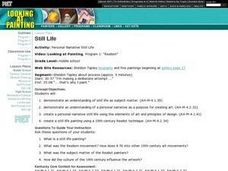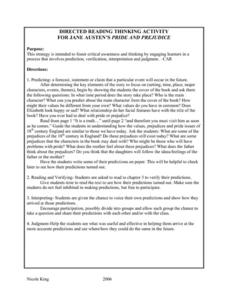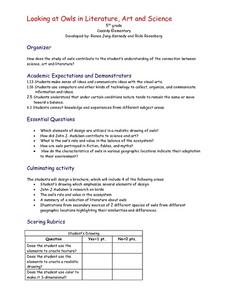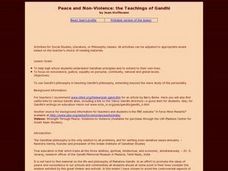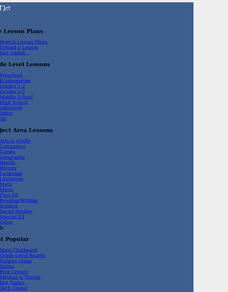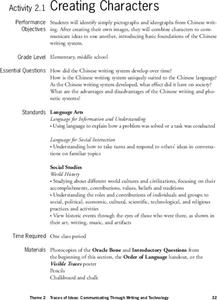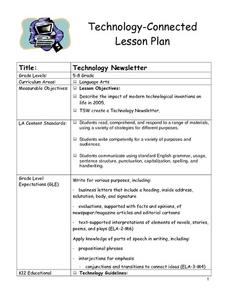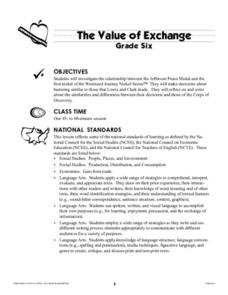Curated OER
Still Life - Realism
Students discuss still life painting and the Realism style of art. They plan a personal narrative still life drawing, complete the project and present it to the class.
Curated OER
Silhouettes and Interiors
Students create a multimedia piece that integrates drawing and collage. Students learn about metacognition and the discovering of self through genres of art and literature by using these steps: inspiration, brainstorm, application,...
Curated OER
Pride and Prejudice: Directed Reading Thinking Activity
Can you judge a book by its cover? Decide who and what Jane Austen's Pride and Prejudice is about with a prediction activity. Before reading the first three chapters of the book, kids answer questions based on their interpretation of the...
Curated OER
Introduction To Composition And Elements Of Design
High schoolers create a finished drawing with a dynamic, asymmetrical composition. Pencil sketches are encouraged for final projects. Students assess their own work prior to submitting the artwork.
Curated OER
Looking at Owls in Literature, Art, and Science
Fifth graders investigate the characteristics of owls through various science and art activities. They analyze drawings by J.J. Audubon and complete a Venn diagram comparing the similarities and differences of different kinds of owls,...
Curated OER
Rangoli - An Art of India
Young scholars respond to image of a rangoli, identify viewing context for selected rangoli image and how this affects viewer's ability to understand the artwork, investigate cultural values and purposes of rangoli art, and design and...
Curated OER
Peace and Non-Violence: the Teachings of Gandhi
Students study the Gandhian philosophy. They define certain elements such as power, beauty and discuss what they know about the struggle for independence in India. Finally students collaborate to discuss Gandhian principles to extend...
Curated OER
Youth Art Month Pins
Young scholars design and create pins advertising Youth Art Month and incorporating mini versions of famous prints.
Curated OER
Splendid China: Chinese Folktales
Students investigate Chinese culture by reading their folk tales. In this creative writing instructional activity, students practice identifying the different elements in a folk tale and examine the related vocabulary. Students...
Curated OER
Monoprint
Students review Gerald Ferstman's work and discuss abstract art. They design and create monoprints on Mylar. They reflect on their work and write about the experience of creating the piece.
Curated OER
Chinese Minority Cultures
Seventh graders identify the elements that characterize culture in literature.
Students analyze the representation of Chinese minority peoples
through textbooks. Students identify and interpret the differences among the people of China.
Curated OER
Shange's Novel Betsey Brown & Jazz
Students read a work of fiction and investigate literary values and structure of the work. They demonstrate understanding of the family values, cultural and historical context of the novel;
Curated OER
Arthur Miller and The Crucible
Students investigate the dramatic elements of The Crucible. In this drama lesson, students explore the elements and themes of the Arthur Miller play as they read the play and watch performances of some of the acts. Students then write...
Curated OER
Cultural Creation Myths
Students write original plays based on supernatural explanations of existence. In this cultural creation myths lesson, students listen to five different stories about supernatural creation. Students record similarities and differences in...
Curated OER
Scrapbooks, The Collecting of Creative Ideas
Students examine the value and use of scrapbooks in writing and historic inquiry. They view and discuss online interactive scrapbooks by Mark Twain, and in small groups create a collaborative scrapbook that reflects the time and place...
Curated OER
Newspaper Poems
Ninth graders appreciate the value of words, review the parts of speech, create original poetry, shape the poem, and write an explanation of the images he/she has created.
Curated OER
Isamu Noguchi/Stone Sculpture
Students examine the art and history of Japan and use it to help them conceptualize and create a work of art that reveals something about their own culture. They examine, interpret and analyze Noguchi's work and reveal information...
Curated OER
Creating Characters
Learners identify simple pictographs and ideographs from Chinese writing. They create their own images, and combine characters to communicate ideas to one another, introducing basic foundations of how elements of the Chinese writing...
Curated OER
Technology Newsletter
Students discuss impact and value of modern technological inventions on society, contemplate world without technology, skim magazines and newspapers for advertisements highlighting modern technologies, and work with partner to create...
Curated OER
Element of Color
Students develop their own original color by using only primary colors, black and white. As a class, they review the warm, cool, secondary and tertiary colors. To end the lesson, they examine the effect of different colors on the human...
Curated OER
Cubism a Fractured Reality - Still Life With Collage Elements
Young scholars gain an understanding and awareness for the cubist style of artists. They create a multi-media composition showing multiple views of various objects and a variety of textures.
Curated OER
The Value of Exchange
Sixth graders examine the relationship between the Jefferson Peace Medal and the nickels in the Westward Journey Series. They make bartering negotiations to similate the ones made by Lewis and Clark. They note the similarities and...
Curated OER
Calculator Art
Students identify the relationships among different parts of a nation's culture. They discover elements of mythology, legends and values.
Curated OER
Double Exposure Lesson Plan: Artistic Analysis of a Photograph
Students view photographs on Web module, practice answering questions of analysis, and identify artistic qualities of photographs by applying the analysis of elements of art.


